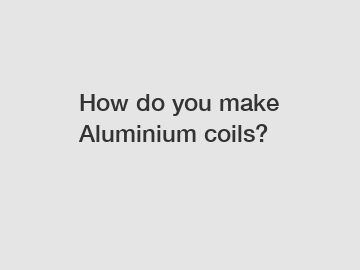How do you make Aluminium coils?
How Do You Make Aluminium Coils?
Aluminium coils are widely used in various industries, including construction, automotive, and aerospace. From packaging to electrical applications, these versatile coils play a crucial role in different sectors. But have you ever wondered how aluminium coils are made? In this article, we will take a closer look at the process of manufacturing aluminium coils, starting from the extraction of aluminium ore to the finished product.
1. Extraction of Aluminium Ore.

The first step in making aluminium coils is the extraction of aluminium ore, also known as bauxite. Bauxite is a reddish-brown rock that is rich in alumina, the main component of aluminium. It is typically mined in open-pit mines in tropical and subtropical regions such as Africa, Australia, and South America. The extracted bauxite is then transported to processing plants for further refinement.
2. Refining Bauxite to Alumina.
Once the bauxite has been mined, it undergoes a refining process to extract alumina. This process usually involves the Bayer method, where bauxite is crushed and mixed with sodium hydroxide. The mixture is then heated and pressurized, which ultimately results in a solution of alumina. The remaining impurities are filtered out, leaving behind pure alumina, which is a white powder.
3. Aluminium Smelting.
After obtaining alumina, the next step is to convert it into aluminium. This is done through a process known as smelting. The alumina powder is mixed with cryolite and placed in an electrolytic cell. Electricity is then passed through the cell, causing the alumina to break down and release oxygen. The resultant aluminium metal settles to the bottom of the cell, where it is collected and cast into ingots.
4. Rolling and Annealing.
Once the aluminium ingots are obtained, they are heated and rolled into long, flat sheets. This process involves passing the ingots through a series of rollers, gradually reducing their thickness and increasing their length. The sheets are then cut into smaller sizes for convenience. However, these sheets are still not in coil form at this stage.
5. Slitting and Recoiling.
To create aluminium coils, the rolled sheets need to be slit into narrower strips. This is done using large slitter machines that cut the sheets into precise widths. Once the slitting process is complete, the strips are recoiled into tight coils using coil winding machines. These coils are then ready for various applications, depending on the industry's requirements.
In conclusion, the manufacturing process of aluminium coils involves several steps, starting from the extraction of bauxite to the final coiling of aluminium strips. The transformation of bauxite into alumina, followed by smelting and rolling, ultimately results in the production of durable and versatile aluminium coils. These coils find applications in numerous industries due to their lightweight, corrosion resistance, and excellent conductivity.
If you have any further questions or would like to learn more about the process of making aluminium coils, please do not hesitate to contact us.
The company is the world’s best types of aluminum coils, painted aluminum coil suppliers, coating aluminum coil china manufacture supplier. We are your one-stop shop for all needs. Our staff are highly-specialized and will help you find the product you need.

Comments
0